Smart and Functional Polymers
A special issue of Molecules (ISSN 1420-3049).
Deadline for manuscript submissions: closed (30 November 2018) | Viewed by 106466
Special Issue Editors
Interests: polymer chemistry; self-assembly; nanoparticle; hydrogel; scaffold; biomaterial; controlled drug delivery; immunotherapy; regenerative medicine
Special Issues, Collections and Topics in MDPI journals
Interests: polymer chemistry; supramolecular self-assembly; nanomedicine; biomaterials; molecular imaging; drug delivery; immunotherapy; cancer surgery
Interests: biomaterials; controlled-release; microphysiological system; microfluidics
Special Issues, Collections and Topics in MDPI journals
Special Issue Information
Dear Colleagues,
Polymerization offers a powerful and modular strategy in generating macromolecules and structures with high complexity and versatile functionality. Smart and functional polymers, to which functional groups are chemically attached, have drawn growing interest as they hold considerable promise for a variety of applications. Smart polymers can be constructed via polymerization of functional monomers or post-polymerization modifications. These polymers possess the combination of the physical properties of nanoscale or microscale architectures and physiochemical reactivities of the attached functional groups. Moreover, their ability to form microscopic and macroscopic assemblies in response to external targets or signals renders unique physiochemical properties (e.g., large surface-to-volume ratio, variable composition and size, dynamic association, and reversible phase separation) and tailored functionalities (e.g., enhanced sensitivity and specificity, extraordinary target binding affinity, and tunable surface chemistry) that are absent in small molecules.
Smart and functional polymeric material is an interdisciplinary field that integrates physics, chemistry, material science, engineering, and biology. Over the past decade, the field has experienced rapid progress as a result of the push by unmet needs in various areas. This Special Issue aims to provide a comprehensive collection of the latest advances in the development of synthetic approaches, mechanism underlying structure-property correlations, and current and emerging applications of smart and functional polymers. The issue will cover smart and functional polymers for a diverse range of applications, involving but not limited in synthetic chemistry, analytical chemistry, materials science, environmental science, industrial fabrication, electronics, renewable energy, food science, agriculture, biomedical technology, and healthcare.
Considering your prominent contribution in this very active field of research, we would like to cordially invite you to submit an article to this Special Issue. Short communications, full research articles, and timely reviews are all welcome.
Dr. Jianxun Ding
Dr. Yang Li
Dr. Mingqiang Li
Guest Editors
Manuscript Submission Information
Manuscripts should be submitted online at www.mdpi.com by registering and logging in to this website. Once you are registered, click here to go to the submission form. Manuscripts can be submitted until the deadline. All submissions that pass pre-check are peer-reviewed. Accepted papers will be published continuously in the journal (as soon as accepted) and will be listed together on the special issue website. Research articles, review articles as well as short communications are invited. For planned papers, a title and short abstract (about 100 words) can be sent to the Editorial Office for announcement on this website.
Submitted manuscripts should not have been published previously, nor be under consideration for publication elsewhere (except conference proceedings papers). All manuscripts are thoroughly refereed through a single-blind peer-review process. A guide for authors and other relevant information for submission of manuscripts is available on the Instructions for Authors page. Molecules is an international peer-reviewed open access semimonthly journal published by MDPI.
Please visit the Instructions for Authors page before submitting a manuscript. The Article Processing Charge (APC) for publication in this open access journal is 2700 CHF (Swiss Francs). Submitted papers should be well formatted and use good English. Authors may use MDPI's English editing service prior to publication or during author revisions.
Keywords
- Polymerization or post-polymerization modification methods
- Polymer-based supramolecular chemistry
- Stimuli-responsive polymers
- Shape memory polymers
- Self-healing polymers
- Polymers for industrial catalysis
- Polymers for water or effluent treatment
- Polymers for sensing, separation, and purification
- Polymers for fabrication
- Renewable polymeric materials used for agriculture
- Functional polymers used in food science
- Polymers for information storage, electronics, and energy conversion
- Functional polymer for diagnosis, imaging, drug delivery, and tissue engineering
- Polymer with biological activity (e.g., anti-tumor, anti-diabetic or anti-microbial activity)
- Polymer-based medical device









